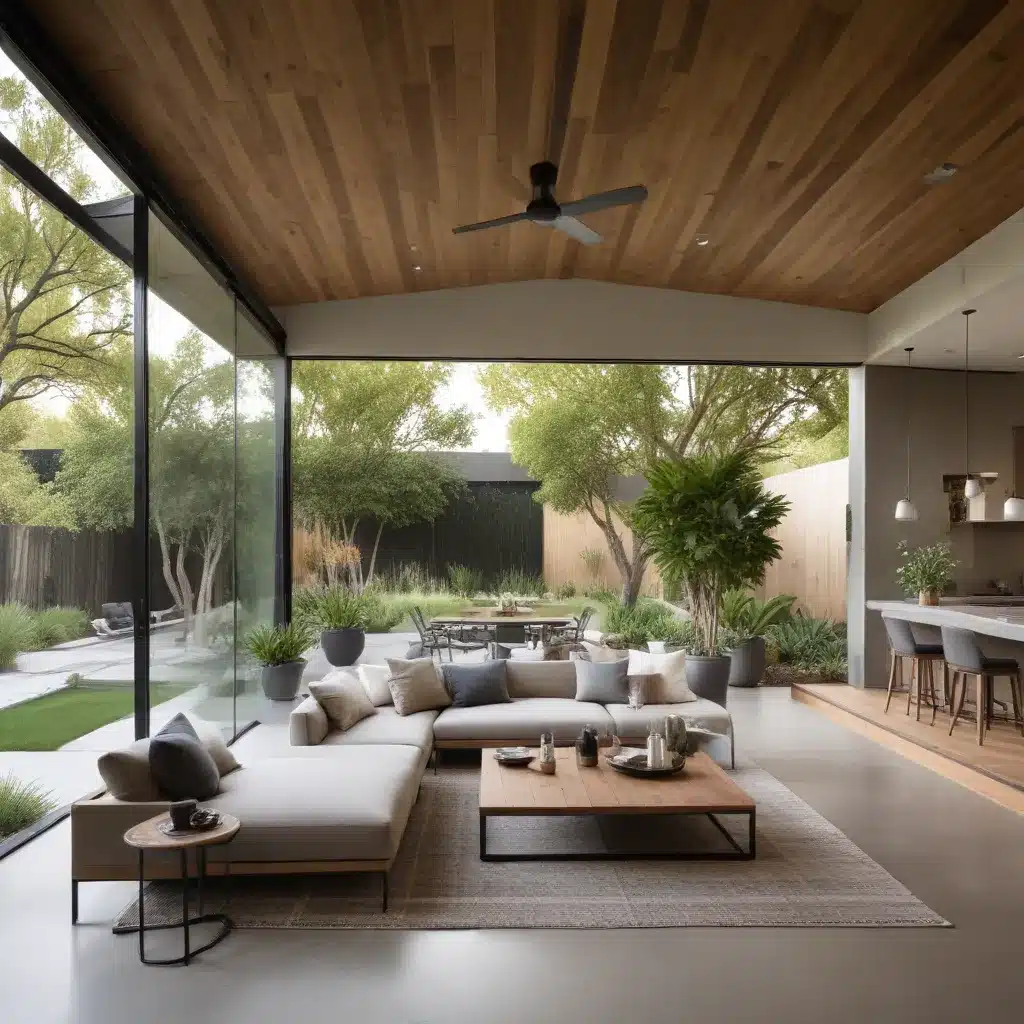
As an experienced home improvement consultant, I’ve seen a growing trend towards creating seamless indoor-outdoor living spaces that blur the lines between our homes and the great outdoors. Whether you’re looking to enhance your family’s lifestyle, elevate your home’s resale value, or simply enjoy the mental and physical benefits of spending more time in nature, designing for an indoor-outdoor flow can be a game-changer.
The Benefits of Indoor-Outdoor Living
One of the primary drivers behind this trend is the proven positive impact on our overall well-being. Studies have shown that increased exposure to natural light, fresh air, and greenery can significantly improve both our mental and physical health. By seamlessly integrating the outdoors into our living spaces, we can reap the rewards of reduced stress, increased productivity, and a greater sense of calm and rejuvenation.
Beyond the personal benefits, an indoor-outdoor living setup also enhances our ability to entertain and relax at home. Imagine being able to host a dinner party where guests can freely move between the kitchen, dining room, and an al fresco lounge area – creating a truly immersive and memorable experience. And on those lazy weekends, you’ll relish the opportunity to unwind in a comfortable outdoor living room, sipping your morning coffee while soaking in the sights and sounds of nature.
The investment in an indoor-outdoor renovation can also pay dividends when it comes time to sell your home. Properties that offer versatile, well-designed outdoor living spaces tend to command higher prices and attract a wider pool of potential buyers. Plus, the increased curb appeal and sense of living in harmony with the environment can make your home stand out in a competitive real estate market.
Designing for Seamless Transitions
The key to successful indoor-outdoor living lies in the careful design of the transitions between your home’s interior and exterior. One of the most impactful decisions you’ll make is the selection of your doors and windows. Bi-folding doors, sliding glass walls, and large picture windows can create a virtually seamless connection, allowing you to blur the boundaries between indoors and out.
When choosing your outdoor furnishings and decor, look for materials that will withstand the elements while still complementing the aesthetic of your interior spaces. Weatherproof fabrics, durable wicker or acacia wood, and low-maintenance planters can all help to create a cohesive and inviting atmosphere. Don’t forget to consider the placement of your outdoor furniture, ensuring that it’s oriented to take advantage of the best views and natural light.
Lighting and landscaping also play crucial roles in crafting a harmonious indoor-outdoor experience. Strategically placed path lighting, wall-mounted sconces, and discreet recessed fixtures can illuminate your outdoor living areas while maintaining a sense of tranquility. And by carefully curating your landscaping, you can create a lush, natural backdrop that enhances the overall ambiance and helps to visually tie your home to its surroundings.
Blurring the Lines Between Indoors and Out
One of the most effective ways to achieve a seamless indoor-outdoor living experience is through the use of open floor plans and flexible, multi-purpose spaces. By minimizing physical barriers and creating a fluid layout, you can encourage a constant flow between your home’s interior and exterior. This can be as simple as removing a wall to open up the living room to the backyard, or as complex as designing a true great room that seamlessly transitions from the kitchen to an outdoor kitchen and dining area.
Incorporating natural materials and textures can also help to bridge the gap between your home’s interior and the outdoors. Wood, stone, and natural fabrics can create a sense of visual continuity, while large windows and sliding glass doors allow you to enjoy unobstructed views of your outdoor oasis. Even small touches, such as potted plants and natural fiber rugs, can contribute to the overall feeling of harmony between your indoor and outdoor living spaces.
Practical Considerations for All-Season Use
To ensure that your indoor-outdoor living experience is enjoyable year-round, it’s important to consider climate-appropriate design solutions. Covered patios, retractable awnings, and screened-in porches can provide protection from the sun, wind, and rain, allowing you to make the most of your outdoor spaces throughout the changing seasons. And for colder climates, outdoor fireplaces, patio heaters, and insulated glass walls can extend the usability of your outdoor living areas well into the fall and winter months.
Regardless of your local climate, weatherproofing and climate control will be essential to maintaining the integrity and comfort of your indoor-outdoor living spaces. Proper insulation, weather-resistant building materials, and high-efficiency HVAC systems can help to regulate temperature and humidity, ensuring that your home remains a haven of relaxation and entertainment no matter the weather.
Of course, with any major home renovation, it’s crucial to have a plan in place for ongoing maintenance and upkeep. Routine cleaning, protective sealants, and occasional touch-ups will help to preserve the beauty and functionality of your indoor-outdoor living areas for years to come. By staying proactive with your maintenance, you can enjoy the countless benefits of seamless indoor-outdoor living without the hassle of constant repairs.
Whether you’re tackling a full-scale renovation or simply looking to make some strategic improvements, incorporating indoor-outdoor design principles can be a transformative experience for your home and your lifestyle. By blending the boundaries between your living spaces and the great outdoors, you’ll create a sanctuary that nourishes both your body and your soul – a true oasis of comfort, relaxation, and connection with nature. To learn more about achieving the perfect indoor-outdoor living setup, be sure to explore the wealth of resources available on the Reluctant Renovator website.



